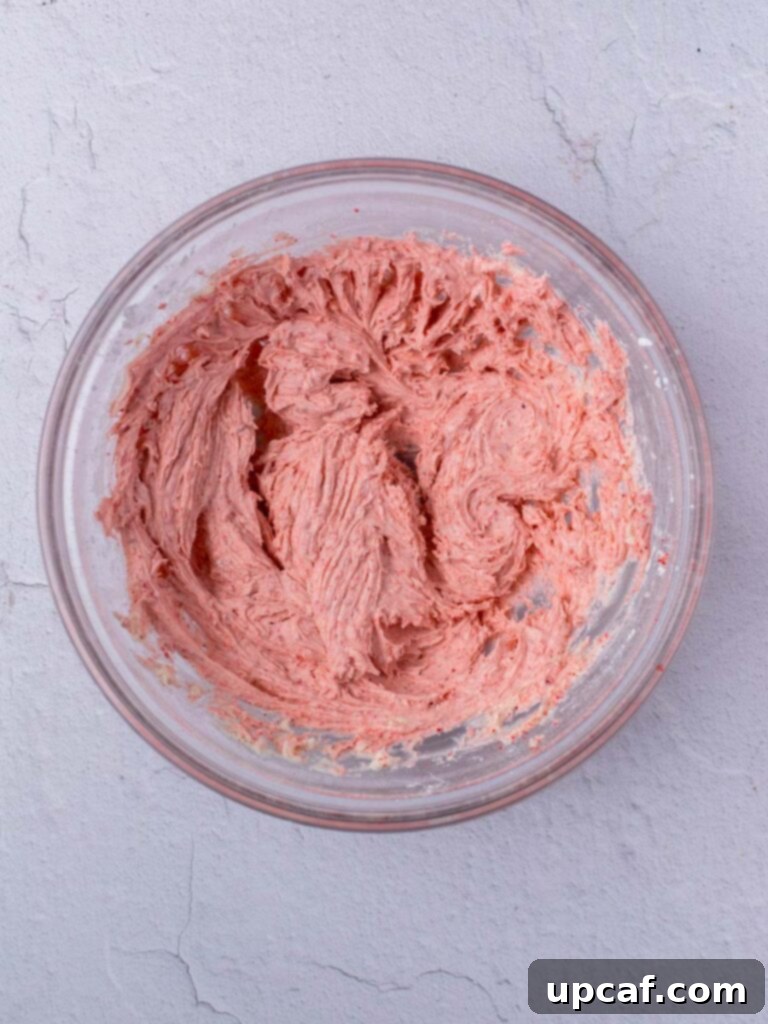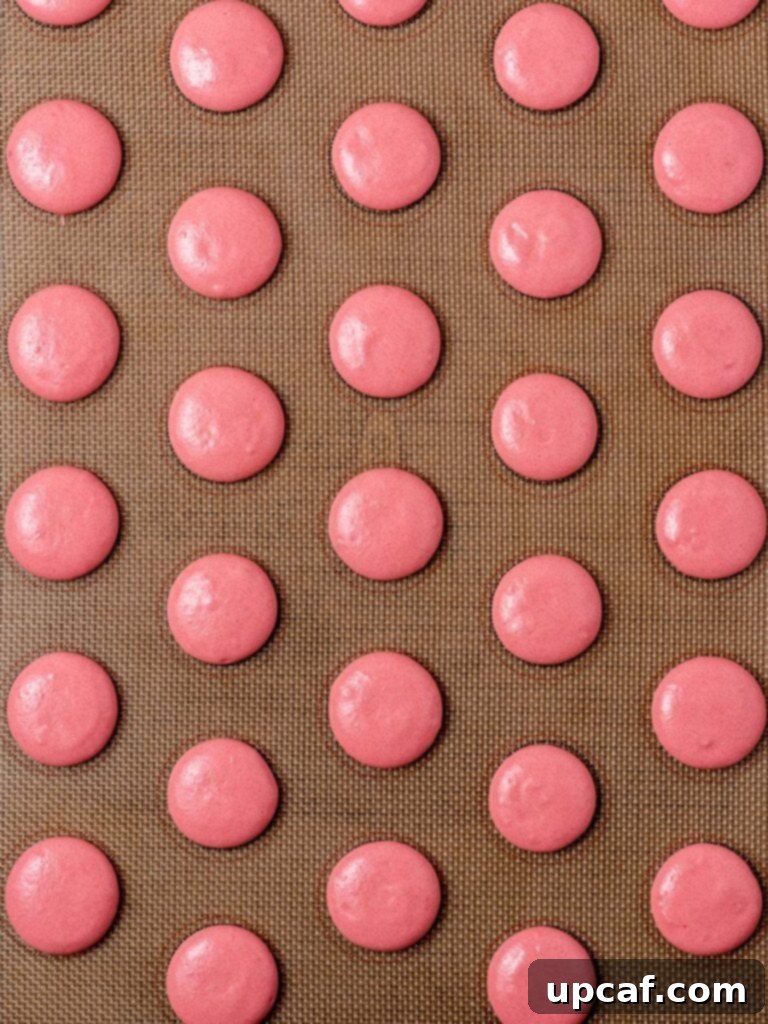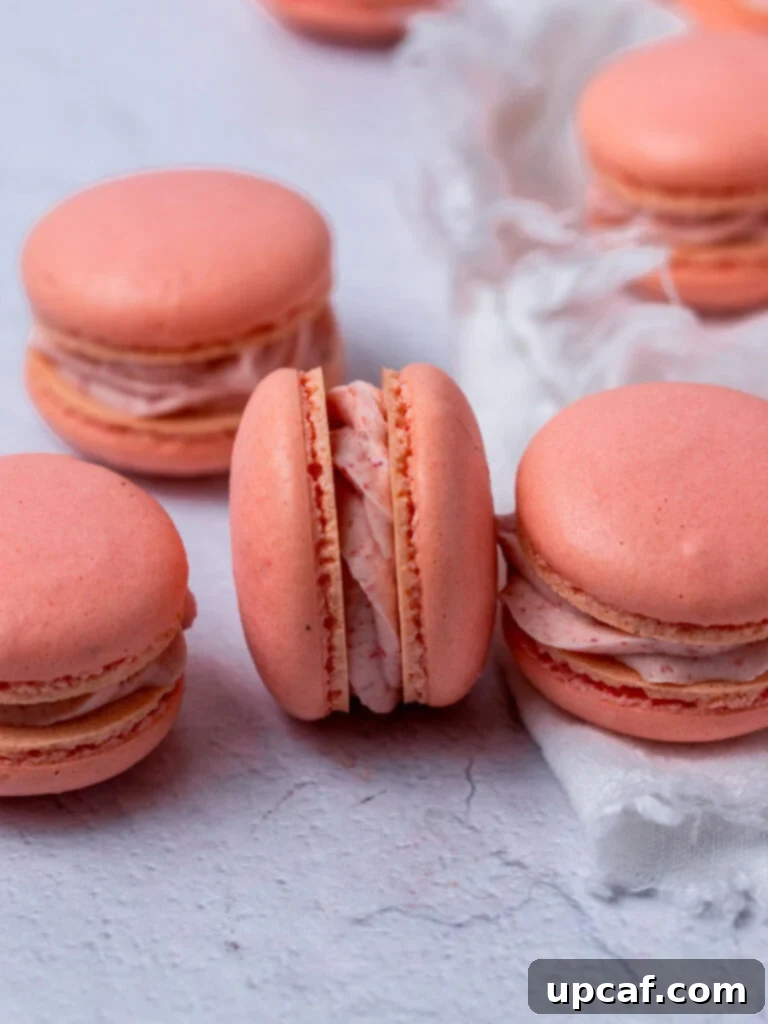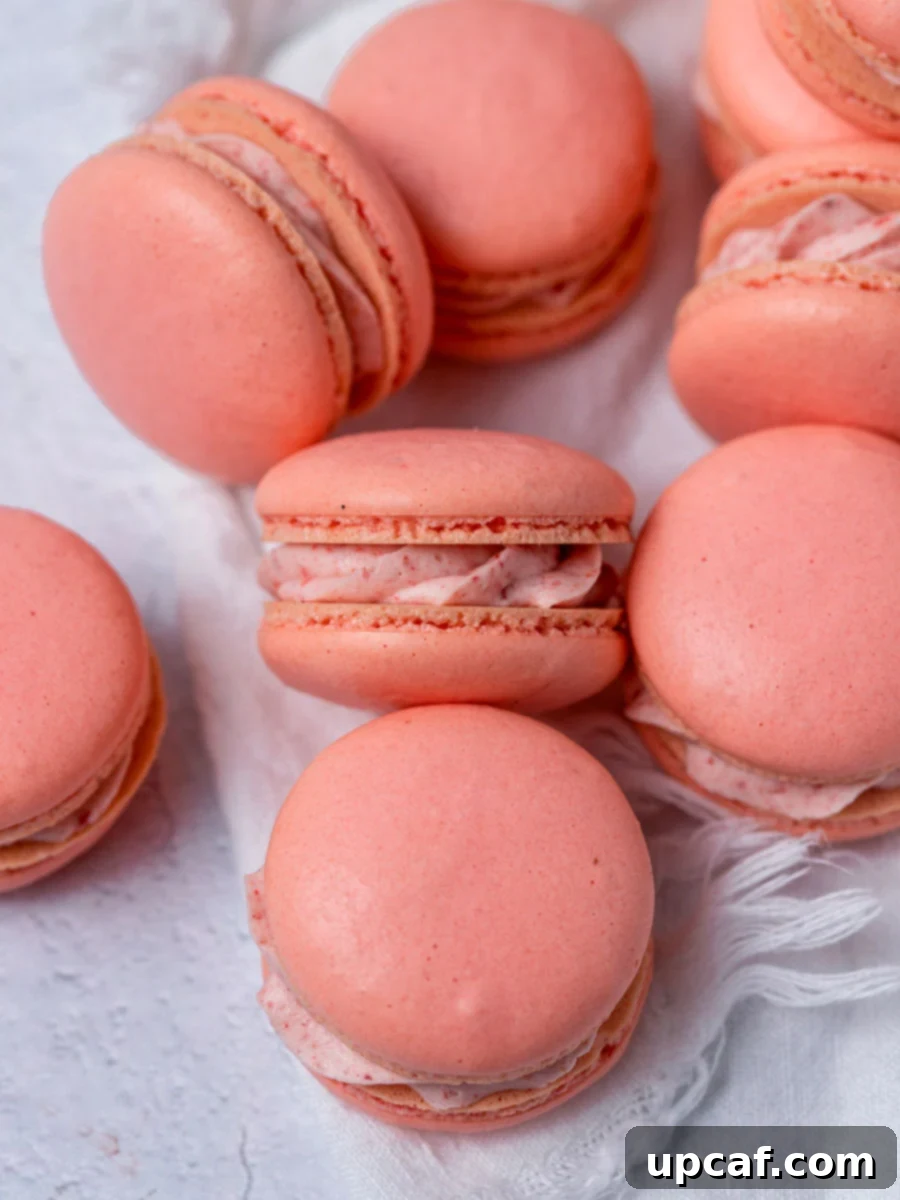Mastering Delicious Strawberry Macarons: Your Guide to Perfect Pink French Delights
Prepare to be enchanted by the delicate allure of homemade Strawberry Macarons! With their signature crisp shell, delightfully chewy interior, and luscious strawberry cream filling, these vibrant pink treats are surprisingly easy to master. Forget complicated patisserie techniques; this comprehensive guide will walk you through every step, ensuring you bake beautiful, bakery-quality French macarons right in your own kitchen.

Dreaming of elegant, pastel pink macarons for a special occasion? Whether it’s Valentine’s Day, an anniversary, a birthday, or simply a desire to treat yourself to something extraordinary, making your own strawberry macarons is a rewarding endeavor. While French macarons have a reputation for being finicky, success is absolutely achievable with precise measurements, careful technique, and a little patience. This detailed strawberry macaron recipe simplifies the process, transforming a seemingly complex dessert into an accessible and enjoyable baking project.
Looking for more exquisite dessert ideas? Explore these other delightful recipes: Molten Chocolate Lava Cake, Red Velvet Macarons, or Easy Chocolate Covered Strawberries.
Why You’ll Adore These Homemade Strawberry Macarons
- Economical Indulgence: Macarons can be quite pricey at bakeries. Making them at home significantly reduces the cost, allowing you to enjoy a luxurious treat without breaking the bank. It’s especially perfect for preparing thoughtful, handmade gifts for loved ones.
- Unforgettable Flavor and Texture: These aren’t just pretty faces! Each strawberry macaron shell offers a delicate crispness that gives way to a wonderfully soft and chewy center. The star of the show, the strawberry cream filling, is bursting with natural fruit flavor, creating a perfect balance of sweet and tangy notes that will tantalize your taste buds.
- Freezer-Friendly for Future Enjoyment: Planning ahead is a breeze! The macaron shells can be baked and frozen for up to a month, making them an excellent make-ahead dessert. You can whip up a big batch and assemble them closer to your event, saving valuable time and effort.
- Impressive & Customizable: There’s an undeniable “wow factor” when presenting a plate of homemade French macarons. The beautiful pink hue of these strawberry delights is naturally festive and appealing. Plus, once you master the basic technique, you can experiment with various colors and flavors, making macarons a truly versatile dessert.
- A Rewarding Baking Experience: While the process requires attention to detail, the journey of making macarons is incredibly satisfying. Watching your delicate shells develop their iconic “feet” and then assembling them into edible works of art provides a wonderful sense of accomplishment.
Understanding the Art of French Macarons
French macarons are celebrated for their distinctive characteristics: delicate, smooth shells with ruffled “feet” at the base, and a soft, slightly chewy interior sandwiching a creamy filling. Unlike American macaroons (which are coconut-based), French macarons are meringue-based confections made primarily from almond flour, powdered sugar, and egg whites. The key to their unique texture lies in a technique called “macaronage,” where the dry ingredients are carefully folded into the meringue to achieve the perfect batter consistency.
Don’t be intimidated by their reputation for being challenging. With the right ingredients, proper preparation, and a keen eye, anyone can achieve macaron success. This strawberry macaron recipe focuses on the French method, which is often considered more forgiving for beginners compared to the Italian or Swiss methods.
Essential Ingredients for Homemade Strawberry Macarons

For the Delicate Macaron Shells:
- Powdered Sugar: Also known as confectioners’ sugar, this fine sugar is blended with almond flour for a smooth shell texture.
- Almond Flour: Crucial for French macarons! Ensure you use super-fine almond flour, not almond meal, which is coarser and can lead to lumpy shells.
- Egg Whites: Ideally, use “aged” egg whites. This means separating them a day or two in advance and letting them sit, covered, in the fridge. This process reduces moisture, helping them whip into a more stable meringue. Bring them to room temperature before whipping.
- Granulated Sugar: Essential for building a strong, stable meringue. It adds structure and sweetness.
- Red or Pink Food Coloring: A few drops create that beautiful, signature strawberry pink hue. Gel food coloring is preferred as it doesn’t add excess moisture.
For the Luscious Strawberry Cream Filling:
- Unsalted Butter: Softened to room temperature for a smooth, creamy buttercream. Unsalted butter allows you to control the salt content.
- Powdered Sugar: Provides sweetness and body to the buttercream, ensuring a silky texture.
- Pinch of Salt: Balances the sweetness and enhances the overall flavor.
- Vanilla Extract: Adds a warm, aromatic depth that complements the strawberry flavor.
- Freeze-Dried Strawberries: This is the secret to an intense, natural strawberry flavor without introducing excess moisture that could destabilize the buttercream. Finely crush them into a powder.
- Milk: Used to adjust the consistency of the buttercream to your desired piping thickness. Start with the recommended amount and add more sparingly if needed.
Step-by-Step Guide: How to Make Strawberry Macarons at Home
Crafting the Perfect Macaron Shells:
- Prepare Your Baking Sheets: Line two large baking sheets with high-quality silicone baking mats or parchment paper. If using parchment, you might want to print or draw macaron templates (1.5-inch circles, spaced apart) and place them underneath for even piping.
- Process and Sift Dry Ingredients: In a food processor, pulse the powdered sugar and almond flour together for about 30 seconds. This step helps to achieve an ultra-fine mixture, eliminating any remaining lumps from the almond flour. Sift the pulsed mixture into a large bowl. Repeat the sifting process once or twice more to ensure the mixture is incredibly fine and airy. Set aside.
- Whip the Meringue: In a meticulously clean, grease-free medium bowl (glass or metal is best), begin beating the room-temperature egg whites on low speed. Once they become foamy and opaque, gradually add the granulated sugar, a tablespoon at a time, while increasing the mixer speed to medium-high. Continue beating until the meringue forms stiff, glossy peaks. When you lift the whisk, the meringue should hold its shape firmly without drooping. Gently fold in your red or pink gel food coloring until evenly distributed. Be careful not to overmix at this stage.

- Perform the Macaronage: This is the most crucial step! Add about one-third of the meringue to the sifted dry ingredients. Using a silicone spatula, gently fold the mixture. Add the remaining meringue in two more additions. Continue folding, scraping down the sides of the bowl, until the batter reaches the proper “lava-like” consistency. The batter should flow off your spatula in a thick, continuous ribbon that slowly melts back into itself within 15-20 seconds. It should not be too runny or too thick. Overmixing will result in runny batter and flat macarons without “feet,” while undermixing will yield lumpy, cracked shells.
- Pipe the Macaron Shells: Transfer the macaron batter to a large piping bag fitted with a round piping tip (such as an Ateco 804 or Wilton 1A). Hold the piping bag perpendicular to the baking sheet and pipe 1-inch disks onto the prepared mats or parchment, following your templates if used. Aim for consistent size and spacing.
- Remove Air Bubbles: Once all shells are piped, firmly tap each baking sheet 5-6 times on your counter. This crucial step helps release any trapped air bubbles from the batter, which can cause cracked shells. Use a toothpick to gently pop any visible air bubbles on the surface of the piped shells.

- Allow Shells to Rest (Form a Skin): Let the piped macaron shells rest at room temperature for at least 30 minutes to 1 hour, or even longer depending on the humidity in your kitchen. This resting period allows a thin “skin” to form on the surface. The shells are ready to bake when you can gently touch them without any batter sticking to your finger. This skin is vital for forcing the air to escape from the bottom, creating those characteristic “feet.”
- Bake to Perfection: Preheat your oven to 325°F (160°C). Place one baking sheet on the center rack of the preheated oven. Bake for 12-15 minutes. To ensure even baking and coloring, rotate the pan every 5 minutes. The macarons are done when the “feet” are clearly visible, and the shells don’t wobble when gently touched.
- Cool Completely: Remove the baked macarons from the oven and allow them to cool completely on the baking sheet before attempting to peel them off. This prevents them from breaking or sticking. Once cooled, gently peel each macaron shell off the mat. Match similarly sized shells together, ready for filling.
Crafting the Delightful Strawberry Cream Filling:
- Beat the Butter: In a medium bowl, use a hand mixer to beat the softened unsalted butter until it’s smooth, light, and creamy.
- Incorporate Powdered Sugar: Add half of the powdered sugar to the butter and mix on low speed until fully combined and no dry spots remain.
- Add Flavorings: Scrape down the sides of the bowl. Add the remaining powdered sugar, salt, vanilla extract, and the finely crushed freeze-dried strawberries. Mix again on low speed until all ingredients are thoroughly combined.
- Achieve Creamy Consistency: Pour in the milk and beat the mixture on medium-high speed for about 3-5 minutes, until the buttercream is light, fluffy, and smooth. If the buttercream seems too thick for piping, add a tiny bit more milk (half a teaspoon at a time) until your desired consistency is reached.
- Assemble the Macarons: Transfer the strawberry buttercream to a piping bag fitted with a round or star piping tip. Pipe your desired amount of filling onto the flat side of one macaron shell. Gently place a matching shell on top, twisting slightly to create a neat sandwich. Repeat with the remaining shells and filling.

Common Macaron Troubleshooting: Why Did My Macarons Not Turn Out?
Macarons are often described as temperamental, but most issues can be traced back to a few common culprits. Understanding these can help you achieve perfect results every time.
Why Don’t My Macarons Have “Feet”?
The iconic ruffled “feet” are a hallmark of a well-made French macaron. If your strawberry macarons lack these, it’s typically due to one of two main reasons:
- Over-Mixed Batter (Macaronage): If you fold the batter too much during the macaronage stage, it becomes too thin and runny. This causes the batter to spread excessively during baking, preventing the air from escaping correctly and forming the feet. The batter needs to be a “lava-like” consistency, flowing in a thick ribbon that slowly melts back into itself.
- Insufficient Resting Time: Skipping or shortening the resting period (the time when the shells dry out) is another common cause. A proper skin needs to form on the surface of the piped shells. This skin acts as a barrier, forcing the air in the batter to rise and escape from the bottom edge, creating the feet. Ensure you can gently run your finger over the surface of the macaron without any batter sticking to it before baking. Resting time varies greatly with kitchen humidity; it could be 30 minutes to 2 hours or more.
Why Are My Macarons Cracked?
Cracked shells are usually a sign of too much trapped air trying to escape during baking.
- Under-Mixed Batter: If your batter is too thick (undermixed), it contains too many large air bubbles. These bubbles will burst through the surface of the shell as they expand in the oven, causing cracks. Ensure your macaronage is adequate, allowing the batter to flow smoothly.
- Insufficient Tapping: Not tapping the baking sheets firmly enough after piping means that many air bubbles remain trapped inside the shells. These will lead to cracks during baking.
- Oven Temperature Too High: An oven that is too hot can cause the shells to rise and set too quickly before the air has a chance to escape properly, leading to cracks. Always use an oven thermometer to ensure accuracy.
Why Are My Macarons Hollow?
Hollow shells are common for beginners. This means the top crust forms too quickly, but the inside doesn’t bake evenly, creating a void.
- Oven Temperature: Often linked to uneven or too high oven temperature. A slightly lower temperature or longer baking time might help.
- Over-whipped Meringue: A meringue that is too stiff can sometimes contribute to hollowness. Aim for stiff, but not dry, peaks.
- Under-baked: If the macarons are removed from the oven too soon, the internal structure may not have fully set.
Why Are My Macarons Lumpy or Bumpy?
Lumpy shells usually indicate that your dry ingredients were not fine enough.
- Insufficient Sifting: Make sure you sift the almond flour and powdered sugar together multiple times. Using a food processor beforehand also helps break down any larger bits.
Why Are My Macarons Sticky?
If your macarons stick to the mat, they are likely under-baked.
- Under-baked: Give them a few more minutes in the oven. They should peel off cleanly when fully cooled.
- High Humidity: Baking in very humid conditions can also contribute to stickiness.
Frequently Asked Questions About Strawberry Macarons
Here are answers to some common questions about making and enjoying strawberry macarons:
How do I pipe even macaron shells consistently?
Achieving perfectly uniform shells comes with practice, but there are tools to help. You can purchase silicone baking mats with pre-printed circles, which serve as excellent guides. Alternatively, if using parchment paper, you can print a macaron template from online resources and place it under your parchment before piping. Just remember to remove the paper template before baking! Always hold your piping bag straight up, perpendicular to the baking surface, and apply even, steady pressure.
Why are my strawberry macarons cracked?
Macaron shells typically crack if there’s too much trapped air that bursts during baking, or if the batter is under-mixed. If the batter is too thick and hasn’t been properly deflated during macaronage, excess air gets trapped. Additionally, not tapping the baking sheets firmly enough to release air bubbles can lead to cracking. Ensure proper macaronage and ample tapping!
How can I flavor my macarons, especially with strawberry?
For these strawberry macarons, we use freeze-dried strawberries, which are fantastic because they deliver intense, natural fruit flavor without adding moisture to the delicate buttercream. You can finely crush them into a powder and incorporate them into your filling. For other flavors, consider using flavor extracts (ensure they are oil-based or very concentrated to avoid adding too much liquid), citrus zest, cocoa powder, coffee powder, or other finely ground freeze-dried fruits.
Can I put toppings on my strawberry macarons?
Absolutely! Toppings can add extra visual appeal and texture. For decorations before baking, you can gently sprinkle nonpareil sprinkles, edible glitter, or finely chopped nuts on top of the piped shells immediately after tapping and before they form a skin. After assembly, consider drizzling melted white or dark chocolate over the finished macarons, or even a light dusting of powdered sugar.
How do I store leftover strawberry macarons?
To keep your macarons fresh, place any leftover assembled strawberry macarons in an airtight container. Store them in the refrigerator for up to one week. Macarons actually “mature” in the fridge, meaning the filling slightly softens the shell, leading to a more harmonious texture. They often taste even better a day or two after assembly!
How do I freeze macaron shells or assembled macarons?
Freezing is a great way to preserve macarons. If you want to freeze just the shells, ensure they are completely cooled, then layer them in an airtight container with parchment paper between layers. Freeze for up to a month. Thaw at room temperature for a few hours before filling. You can also freeze assembled macarons: first, let them “mature” in the fridge for 24-48 hours. Then, place them in a freezer-safe airtight container, again with parchment paper between layers, and freeze for up to a month. Thaw in the refrigerator overnight before serving.
Can I use regular flour instead of almond flour?
No, French macarons specifically require almond flour. Regular all-purpose flour has different protein and gluten content, and its texture is not suitable for achieving the delicate, chewy consistency of macaron shells. Using regular flour will result in a completely different, unsatisfactory product.
What exactly are freeze-dried strawberries?
Freeze-drying is a process that removes all moisture from a food item while largely preserving its original shape, nutrients, and intense flavor. For baking, freeze-dried fruits are invaluable as they provide concentrated flavor without introducing any extra liquid that could interfere with delicate recipes like macaron fillings or meringues.
What is “aged” egg white, and why is it important for macarons?
“Aged” egg whites are simply egg whites that have been separated from the yolks and left to sit, covered loosely, in the refrigerator for 24-48 hours. This process allows some of the moisture in the egg whites to evaporate, leading to a more stable and stronger meringue when whipped. A stable meringue is critical for achieving perfect macaron shells with good height and feet.
Do I really need a kitchen scale for macarons?
Yes, absolutely. For French macarons, precision is paramount. Using a kitchen scale to weigh all your ingredients (especially the almond flour, powdered sugar, and egg whites) ensures accuracy that volume measurements simply cannot provide. Even small discrepancies in ingredient ratios can significantly affect the outcome of your macaron batter.
More Delightful Desserts to Explore
- Lemon French Madeleines Cakes
- Strawberry Jam Linzer Cookies
- Cheesecake Brownie Fudge Bars
- Chocolate Chip Cheesecake
- Coconut Cheesecake Bars

We hope this detailed guide empowers you to create the most exquisite Strawberry Macarons right in your own kitchen. Baking macarons is a delightful journey, and the reward of biting into these perfectly crafted, strawberry-infused treats is truly unparalleled. Don’t be afraid to try, learn from any mishaps, and celebrate your successes!
If you bake these delightful strawberry macarons, we would love to see your creations! Please share them using our hashtag on INSTAGRAM for a chance to be featured. For more delicious recipes and baking inspiration, be sure to follow Cookin’ With Mima on FACEBOOK | INSTAGRAM | PINTEREST.

Strawberry Macarons
By: Mariam Ezzeddine
Soft and chewy inside, crisp on the outside, making these delightful Strawberry Macarons is unbelievably easy! They offer a charming pink variation to the traditional French macaron, ensuring a fun and enjoyable baking experience with this strawberry macaron recipe!
Prep Time: 30 minutes
Cook Time: 15 minutes
Resting Time: 1 hour
Total Time: 1 hour 45 minutes
Servings: 30 macarons
Ingredients
For Shells:
- 1⅔ cup powdered sugar
- 1 cup almond flour
- 3 whole large egg whites (aged, at room temperature)
- ¼ cup granulated sugar
- 1-2 drops red or pink gel food coloring
For Buttercream:
- 1 stick (½ cup) unsalted butter, softened
- 2 cups powdered sugar
- 1 pinch of salt
- 1 tsp. vanilla extract
- ⅓ cup freeze-dried strawberries, finely crushed
- 3 tbsps. milk, more as needed
Instructions
Preheat oven to 325 F (160°C).
For Shells:
- Line a baking sheet with a silicone baking mat or parchment paper.
- Use a food processor to pulse the powdered sugar and almond flour until fully combined and rid of lumps. Sift the combined ingredients into a large bowl. (If you do not have a food processor, sift ingredients together multiple times). Set aside.
- In a medium, clean bowl, beat the egg whites on low speed until they start to get foamy. Slowly add the granulated sugar and increase the speed. Beat the mixture until stiff, glossy peaks form.
- Add the meringue into the dry ingredients. Using a silicone spatula, gently fold the two together. Add in the food coloring and whisk to combine. Continue folding until the batter reaches a “lava-like” consistency, flowing in a thick ribbon that slowly melts back into itself (the macaronage stage).
- Transfer the mixture to a piping bag fitted with a round piping tip. Pipe about 1.5-inch disks onto the prepared baking sheet.
- Firmly tap the baking sheet 5 or 6 times on the counter to bring any air bubbles to the surface. Use a toothpick to pop any remaining bubbles.
- Let the macarons rest for at least 1 hour, or until a thin skin forms on the surface and the batter does not stick to your finger when gently touched.
- Place the baking sheet on the center rack of the preheated oven (325°F/160°C) and bake for 15 minutes, rotating the pan every 5 minutes to ensure even baking and coloring.
- Remove the macarons from the oven and allow to cool completely on the baking sheet before peeling them off.
- Gently peel each cooled macaron off the mat and match up with a similarly sized cookie.
For Buttercream:
- In a medium bowl, with a hand mixer, beat the softened butter until smooth and creamy. Add half of the powdered sugar and mix until combined.
- Add the other half of the powdered sugar, salt, vanilla extract, and finely crushed freeze-dried strawberries. Mix until fully combined.
- Add the milk and beat for 5 minutes or until smooth and fluffy. If the buttercream is too thick, slowly add more milk (½ tsp at a time) until the desired consistency is reached.
- Transfer the buttercream to a piping bag fitted with a piping tip. Pipe your desired amount onto the inside of one macaron shell and sandwich together with a matching cookie.
Notes
- For even shells, use silicone mats with printed circles or a template under parchment paper.
- Always pipe shells straight down, not at an angle.
- Do not overmix the macaron batter during the macaronage stage to prevent flat macarons without feet.
- Aged egg whites (separated and left in the fridge for 24-48 hours) can lead to more stable meringues. Bring to room temperature before whipping.
- Use a kitchen scale for precise ingredient measurements, which is crucial for macaron success.
Nutrition
Serving: 1 macaron (out of 30) | Calories: 125 kcal | Carbohydrates: 20g | Protein: 1g | Fat: 5g | Saturated Fat: 2g | Trans Fat: 1g | Cholesterol: 8mg | Sodium: 8mg | Potassium: 44mg | Fiber: 1g | Sugar: 18g | Vitamin A: 97IU | Vitamin C: 32mg | Calcium: 11mg | Iron: 1mg
